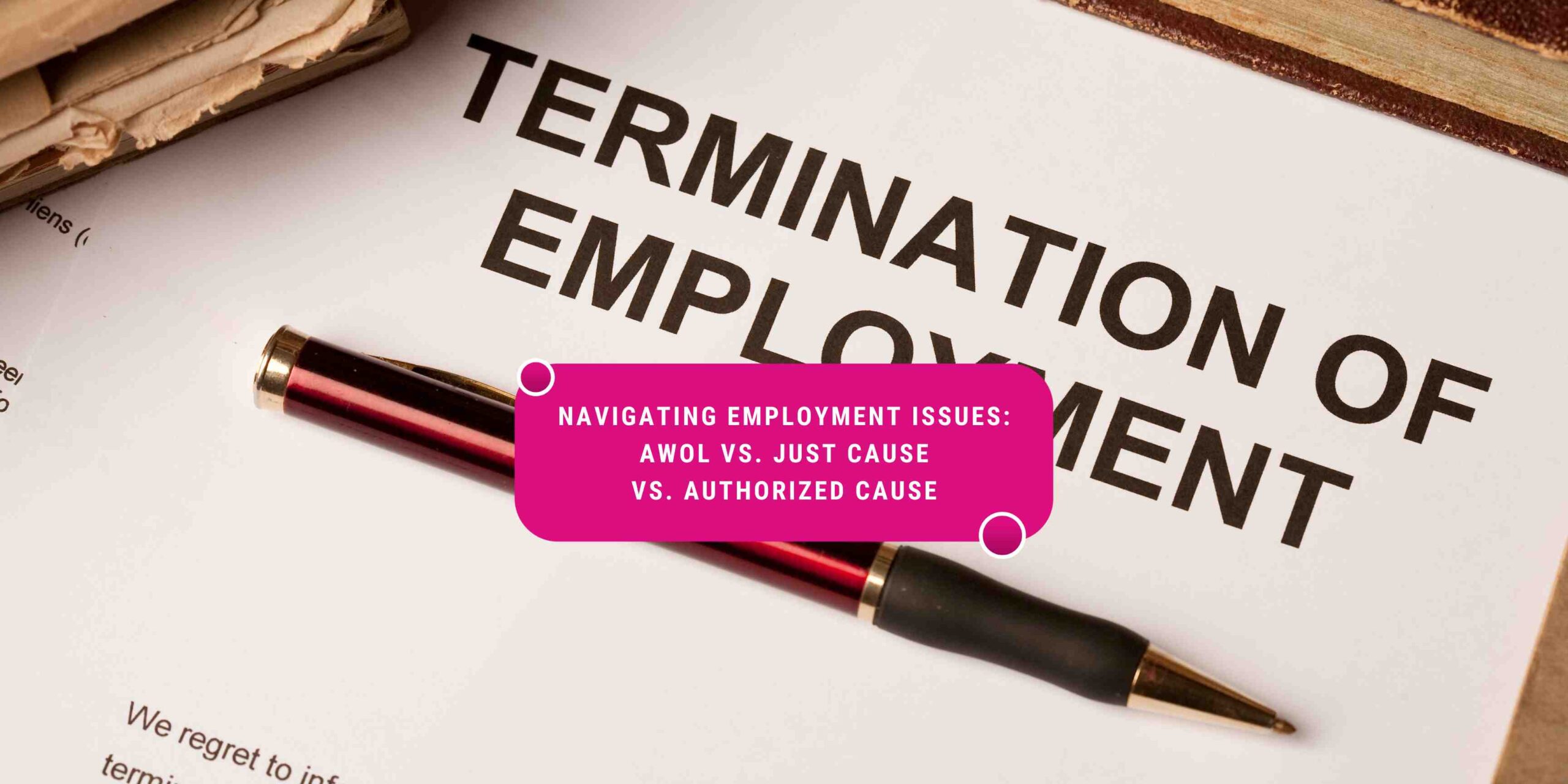Understanding AWOL
AWOL can take many forms including a complete failure by an employee to start work, a failure to return to work after a break or the taking of a day’s sick or other leave without proper authority. The distinction between the forms of absence is unimportant. What is important is the reason for the absence. The reason for the absence must be more than a personal frolic or an abandonment of the job. If there is a reasonable excuse for the absence, there can be no finding of guilt for AWOL. This is where the concept of authorised cause is raised. An employee who can prove an authorised cause for an absence cannot be justifiably dismissed for the absence. The problem is that lack of understanding of the nuances of the principles of AWOL and authorised cause often lead to poor decision making by employers and undefined outcomes for employees who have infringed the employer’s right to enforce discipline and control.
Awol means “absence without leave from work.” It is a term that has been imported into our industrial relations system from the military where it refers to the situation of a soldier being absent from duty without permission. Both local and overseas military tribunals have long struggled with the question of what constitutes a sufficient foundation for guilt and convictions for the offence. In the industrial context, AWOL infringes the employer’s right to employees’ services and the right to enforce reasonable discipline and control over its employees. It is thus a breach of the employee’s obligations to his or her employer.
Exploring Just Cause
Although the Labor Code does not define such causes, social and jurisprudential developments reveal that just cause must be supported by evidence of the acts or omissions complained of. Between the just cause of an employer, in layman’s view, and its legal definition to support a valid termination, the distinction is substantive. Acts or omissions serious in nature and analogous to a crime, particularly under Article 282, must be proved. Anent these, to be a valid ground for dismissal, it is necessary that they be both serious and work-related. Seriousness is a qualitative term pertaining to the gravity of the offense and would include, among other things, the damage and prejudice caused by the employee, cause and effect between the act and the damage, as the logical relationship of an act or an event to the prevailing in re; and finally, whether the offense was a single isolated event or which constitutes a series of recurrence. Coming closing to the statutory ground, it is clear that the crime is misconduct and is a serious act. But not all misconduct or lack of diligence on an employee’s part, which are sometimes synonymous with a transgression, command just disciplinary action or termination, as the wrong is a crime of wrongful intention with thinks of its prideful folly. Thus, an administration suspension is a penalty for the lesser case of misconduct. But is it just disciplinary cause for dismissal of an employee under mere lack of trust and confidence to the incriminating case of act or omission, even though it is for a legal ground, may be an analogy to an act of crime. This has always been affirmed in many labor cases and depends on the totality of the facts and the employer’s, not the employee’s, subjective assessment. As to the case wherein an act of an employee is to fulfill a contractual duty or a task given, it would necessarily need to be a failure in the event of poor quality. But it would not constitute cause for termination, just a disciplinary action to oblige to reattempt.
Just cause is another ground for termination of an employee. This is the reason sanctioned by the Labor Code as a legally sufficient ground or reason for termination of employment. It is difficult to define just cause in the abstract; the determination of whether just cause exists will, in general, be an objective determination by the Court.
Unpacking Authorized Cause
We can help you in your cases about just cause and authorized cause. There are three kinds of terminations initiated by the employer’s act, namely: (1) termination for an authorized cause; (2) termination for just causes; and (3) termination for health reasons. Termination of employment for health reasons can either be a just cause or an authorized cause, since the well-being of the employee and his co-employees must not be endangered by a continuing employment of an employee whose health is prejudicial to himself or to others. This does not mean that an employer can terminate the services of an employee due to health reasons, no matter how serious, whenever he desires. There must still be a termination process and the employer must prove that the health condition of the employee is such as to render him unfit for his present work and there is no suitable employment which may be given to him by the employer. Terminations for health reasons are not the focus of this essay however. We shall concern ourselves with the first and third kind of terminations. Termination for a just cause means that the fault of the employee is such that it cannot be excused. There is no question as to his capacity, his zeal in the work, or even his amiable personality towards his employer. These are not to be confused with mitigating circumstances to determine whether the guilt of the employee is a just cause for termination. Termination for an authorized cause is obviously the termination of the employee for business needs. It could be that the employer is dissolving the enterprise, such as when a corporation is going bankrupt or undergoing rehabilitation and impossibility of task in cases when there are not sufficient appropriations for an employee who is a casual or project employee. The difference in rights of employees in these three kinds of termination is crucial, and the specific instances in which an employee may use them will be discussed later.
Key Differences and Similarities
In determining the presence of Just Cause, it is necessary to prove that the employee’s actions leading to the termination were of such a nature as to render the employee’s continuance of employment untenable. Though it is difficult to define what actions would lead to this outcome and may vary depending on the personality or level of tolerance of the management, acts directly entailing breach of duty to employer, whether intentional or negligent, will often resemble the employee’s conduct in an AWOL situation. Similarly, termination due to an employee’s illness or injury preventing the performance of his contract, particularly in an environment where the employer may be thinking in terms of termination due to poor performance, may function akin to a Constructive Dismissal situation. In both cases, the resultant termination will effectively be a termination for Just Cause, as opposed to an employee who is a victim of a brief lapse in performance due to inadequate skill or capacity. Cause and Notice Pay will differ in situations where the employer is able to prove that the employee has committed a serious or deliberate breach of his contract. This leads to the concept of Termination for Cause due to Serious Breach of duty. This is where it may be difficult to distinguish the technical requirements for proving the employee’s actions and his mental intent, from the concept of various forms of Misconduct, and ultimately it will often be the case that the facts would be more apt to an investigation under a Misconduct situation. Terminations for Just Cause will share a commonality with terminations for Serious Breach and Misconduct in that the employer is attempting to avoid paying any form of compensation to the employee. However, it is important to note that compensation penalties for terminations without Just Cause or terminations due to the abolishment of a position may lead to an employer being found guilty of Unjust Dismissal under Section 240 of the Canada Labour Code, and the employee being reinstated to the same position at a time prior to termination. Terminations for AWOL will lead to the employer taking the position that the employee has effectively terminated his contract by abandoning the employment.
Writely or wrongly, AWOL is treated as an offence that goes to the very root of the employee-employer relationship. When an employee is absent from work, the door is opened for the employer to take action on the basis that the absence is a breach of the employee’s duty to provide his service. This would be true regardless of whether the employee is in fact refusing to work, is unable to work, or is legally prevented from working. Given the scarcity of any legal definition for the term “absence” in the context of a breach of contract, there are numerous occasions where it is difficult to draw a line between an absence constituting AWOL and an absence resulting from illness or injury. In the latter case, it may be more appropriate for the employer to take action for a disciplinary breach directly related to the cause of absence, instead of taking action on the absenteeism itself. This then begins to resemble a case of Just Cause termination.
When it comes to actual employee behaviour giving rise to a management action, the distinction between the two concepts is crucial. Their implications directly affect the employer’s prerogatives and the employee’s legal rights. This is where the differences and similarities between AWOL, Just Cause, and Authorized Cause.
Best Practices for Handling Employment Issues
Clients are faced with tough choices when dealing with employment issues like those stated in the introductory paragraph of this paper. It is important to endeavor never to violate the due process rights of the employee, simply because the employer violated the rights of an employee chances are it will have little effect on the judge’s overall decision. Due process is an employer’s greatest weapon and it does not cost a cent. This leads back to the title of this paper, navigation through employment issues can be tricky, but by following a few simple rules the employer can easily avoid any major legal harshness. Taking disciplinary action against an employee may seem like a great way to start an issue, but actually in most cases it is best to attempt to work things out with the employee. In the case of Just Causes if the employee is willing to correct the mistake terminating his employment may not necessarily be the best solution. If a civil case is brought before this issue the plaintiff could argue that he was prevented to work off his wrongdoing. Terminating an employee can sometimes open up a completely different can of worms as opposed to changing the employee’s status or allowing him a chance to correct his mistake. An issue like this is what you might call a lose-lose situation, but it can be commonly avoided by a simple discussion between employer and employee on how to improve the given situation. This will help clarify what each party is thinking and possibly prevent any future mistakes.



